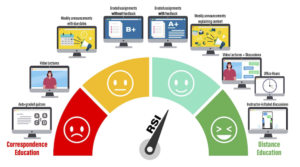Course provides contact information for instructor, department, and program. Review These Explanations In addition to providing this information in the syllabus, including a…
Course objectives/outcomes are clearly defined, measurable, and aligned to learning activities and assessments. Review These Explanations Learning objectives and outcomes are essentially milestones…
Course provides appropriate guidelines for successful participation regarding technical requirements (e.g., browser version, mobile, publisher resources, secure content, pop-ups, browser issues, microphone, webcam). Review These…
Course information states whether the course is fully online, blended, or web-enhanced. Review These Explanations Learners need to know how they can expect…
Course provides access to online learner success resources (support services, orientation, academic honesty, tutoring, technical help). Review These Explanations As more online services…
Course includes links to relevant campus policies on plagiarism, computer use, filing grievances, accommodating disabilities, etc. Review These Explanations Learners should be able…
A printable syllabus is available to learners (PDF, HTML). Review These Explanations Keeping learners on track is a core part of teaching online,…
Course includes a course information area and syllabus that make course expectations clear and findable. Review These Explanations Simunich, Robins, and Kelly (2015)…
Course provides an overall orientation or overview, as well as module-level overviews to make course content, activities, assignments, due dates, interactions, and assessments, predictable and…
Course includes Welcome and Getting Started content. Review These Explanations By welcoming learners to the course and providing context for what they will…













